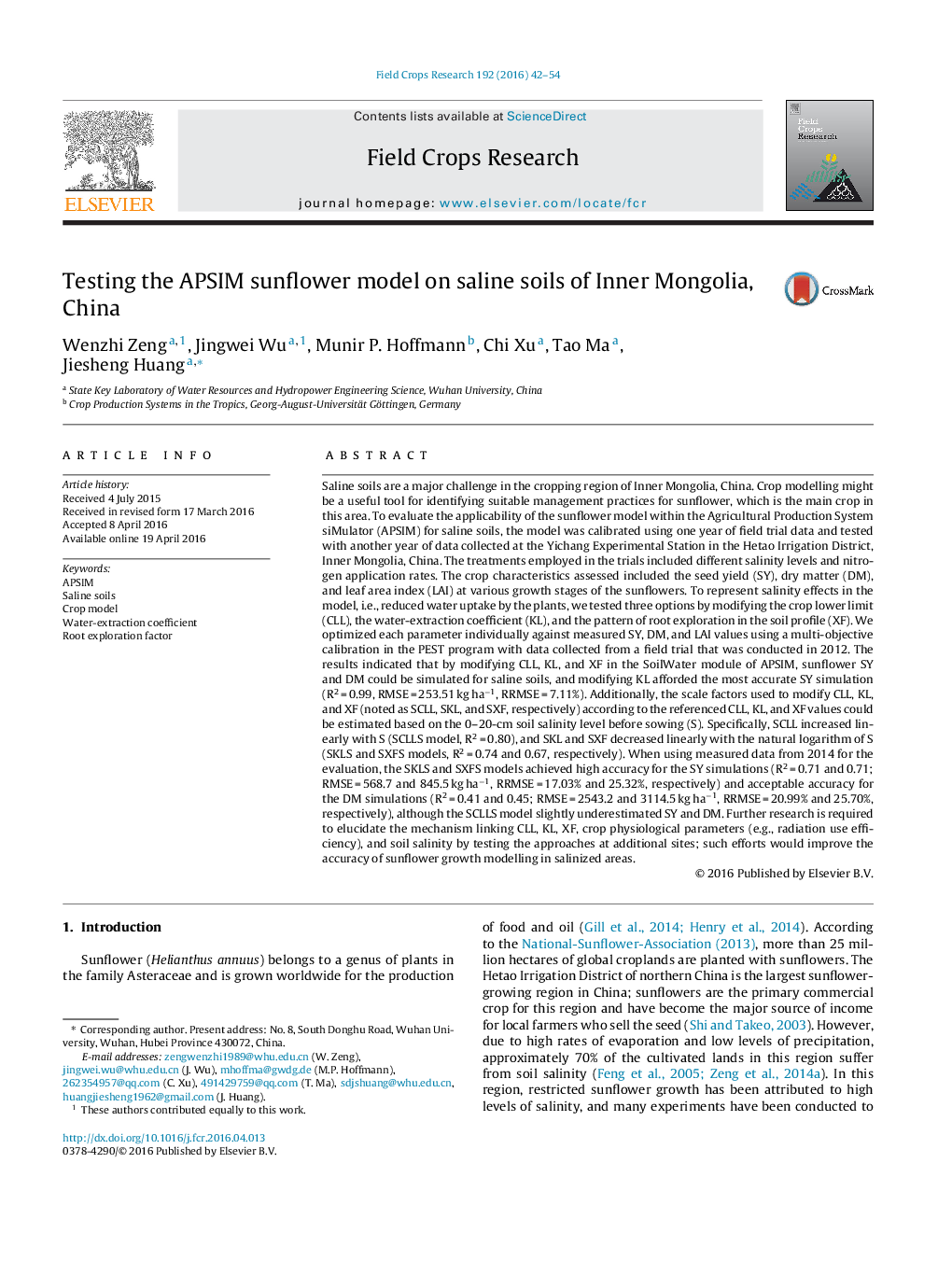| کد مقاله | کد نشریه | سال انتشار | مقاله انگلیسی | نسخه تمام متن |
|---|---|---|---|---|
| 6374481 | 1624671 | 2016 | 13 صفحه PDF | دانلود رایگان |
عنوان انگلیسی مقاله ISI
Testing the APSIM sunflower model on saline soils of Inner Mongolia, China
دانلود مقاله + سفارش ترجمه
دانلود مقاله ISI انگلیسی
رایگان برای ایرانیان
موضوعات مرتبط
علوم زیستی و بیوفناوری
علوم کشاورزی و بیولوژیک
علوم زراعت و اصلاح نباتات
پیش نمایش صفحه اول مقاله

چکیده انگلیسی
Saline soils are a major challenge in the cropping region of Inner Mongolia, China. Crop modelling might be a useful tool for identifying suitable management practices for sunflower, which is the main crop in this area. To evaluate the applicability of the sunflower model within the Agricultural Production System siMulator (APSIM) for saline soils, the model was calibrated using one year of field trial data and tested with another year of data collected at the Yichang Experimental Station in the Hetao Irrigation District, Inner Mongolia, China. The treatments employed in the trials included different salinity levels and nitrogen application rates. The crop characteristics assessed included the seed yield (SY), dry matter (DM), and leaf area index (LAI) at various growth stages of the sunflowers. To represent salinity effects in the model, i.e., reduced water uptake by the plants, we tested three options by modifying the crop lower limit (CLL), the water-extraction coefficient (KL), and the pattern of root exploration in the soil profile (XF). We optimized each parameter individually against measured SY, DM, and LAI values using a multi-objective calibration in the PEST program with data collected from a field trial that was conducted in 2012. The results indicated that by modifying CLL, KL, and XF in the SoilWater module of APSIM, sunflower SY and DM could be simulated for saline soils, and modifying KL afforded the most accurate SY simulation (R2 = 0.99, RMSE = 253.51 kg haâ1, RRMSE = 7.11%). Additionally, the scale factors used to modify CLL, KL, and XF (noted as SCLL, SKL, and SXF, respectively) according to the referenced CLL, KL, and XF values could be estimated based on the 0-20-cm soil salinity level before sowing (S). Specifically, SCLL increased linearly with S (SCLLS model, R2 = 0.80), and SKL and SXF decreased linearly with the natural logarithm of S (SKLS and SXFS models, R2 = 0.74 and 0.67, respectively). When using measured data from 2014 for the evaluation, the SKLS and SXFS models achieved high accuracy for the SY simulations (R2 = 0.71 and 0.71; RMSE = 568.7 and 845.5 kg haâ1, RRMSE = 17.03% and 25.32%, respectively) and acceptable accuracy for the DM simulations (R2 = 0.41 and 0.45; RMSE = 2543.2 and 3114.5 kg haâ1, RRMSE = 20.99% and 25.70%, respectively), although the SCLLS model slightly underestimated SY and DM. Further research is required to elucidate the mechanism linking CLL, KL, XF, crop physiological parameters (e.g., radiation use efficiency), and soil salinity by testing the approaches at additional sites; such efforts would improve the accuracy of sunflower growth modelling in salinized areas.
ناشر
Database: Elsevier - ScienceDirect (ساینس دایرکت)
Journal: Field Crops Research - Volume 192, June 2016, Pages 42-54
Journal: Field Crops Research - Volume 192, June 2016, Pages 42-54
نویسندگان
Wenzhi Zeng, Jingwei Wu, Munir P. Hoffmann, Chi Xu, Tao Ma, Jiesheng Huang,